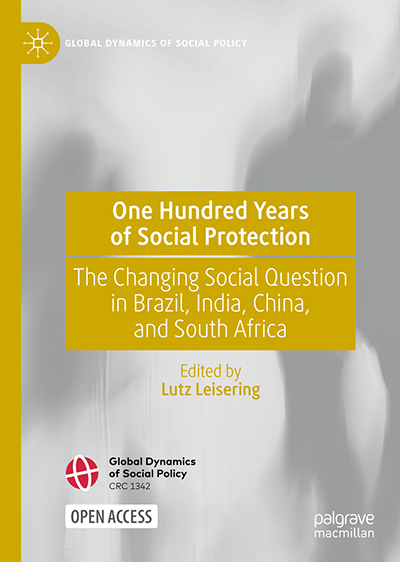
The third volume of the series "Global Dynamics of Social Policy", published by our SFB with Pagrave Macmillan, has been published: Lutz Leiseirng's "One Hundred Years of Social Protection - The Changing Social Question in Brazil, India, China, and South Africa". In the book, Leisering develops a conceptual model that can be used to analyse the development of social policy, also and especially in the Global South. Eight authors then apply this model to the socio-political development of the case studies Brazil, India, China and South Africa. In the interview, Leisering talks about the volume's place in social policy research and the lessons he draws from the case studies of his colleagues.
Your book is conceptually based on the "Onion Skin Model" that you have developed in 2019 in "The Global Rise of Social Cash Transfers". Can you describe the core of the model in a few sentences?
 The onion skin model is based on the assumption that expanded state social policy is preconditional and evolutionarily improbable. This is because social policy not only has material preconditions, but also, neglected in research, ideational and socio-cultural preconditions. The onion-skin model reconstructs the ideational preconditions in four layers or " skins": social policy can only emerge if certain socio-economic conditions are perceived and addressed as "social problems"; if, more generally, the "social question" is recognised as a central issue of social development; if normative and cognitive models of the institutional handling of social problems are developed; and if the state is ascribed a social responsibility for the welfare of all citizens. These four layers reflect national state traditions and citizens' moral and cognitive orientations towards the social question.
The onion skin model is based on the assumption that expanded state social policy is preconditional and evolutionarily improbable. This is because social policy not only has material preconditions, but also, neglected in research, ideational and socio-cultural preconditions. The onion-skin model reconstructs the ideational preconditions in four layers or " skins": social policy can only emerge if certain socio-economic conditions are perceived and addressed as "social problems"; if, more generally, the "social question" is recognised as a central issue of social development; if normative and cognitive models of the institutional handling of social problems are developed; and if the state is ascribed a social responsibility for the welfare of all citizens. These four layers reflect national state traditions and citizens' moral and cognitive orientations towards the social question.
In addition, there is a fifth, outer layer: only when the benefits of social policy for collective concerns - such as economic growth, political stability, national unity or human rights - are demonstrated ("framing"), is social policy sustainably legitimised. If, on the other hand, a collective dysfunctionality of social policy is claimed (negative framing), social policy is delegitimised.
If one examines these five layers for each country, one finds great differences, even between countries with similar levels of economic development. The differentiated layer model goes further than the distinction between major social worldviews - social democracy, conservatism and liberalism - that is common in the political economy of the welfare state and is hardly applicable to the Global South.
It is a model that is not only suitable for analysing the development of social policy in the Global South, but is generally applicable. You have been researching social policy for 30 years. Is the Onion Skin Model something like the culmination of all those years?
Yes, in the Onion Skin Model perspectives converge that have developed over the decades of my involvement with social policy. I researched the welfare states of the Global North for a long time and only turned to social policy in the Global South at a late stage (but as one of the first in Germany). In the attempt to theoretically grasp "social policy in development contexts", I came across basic questions of social policy that arise anew in the Southern context. A mere application of northern theories, as attempted by some, seemed to me to make little sense. In my theoretical search, I was influenced by my academic teacher Franz-Xaver Kaufmann, as well as by my doctoral supervisor at the London School of Economics, Robert Pinker, the most important student of T. H. Marshall. Welfare state theory today is dominated by political economy approaches that are capitalism-theoretical at their core and have their roots in Marx and Polanyi. Kaufmann, on the other hand, has developed a genuinely sociological approach to the welfare state, which is oriented towards modernisation theory and stands in the tradition of Max Weber. In my studies on the Global South, I found that the almost buried modernisation-theoretical tradition is better suited than the political-economic one to grasp social policy in the Global South and even to enable an overarching global theory. The onion-skin model is an operationalisation of essential elements of this genuinely sociological, Weberian approach.
The case studies in your book are largely based on the analysis of historical sources such as documents. An approach we also follow at the CRC 1342, but in your book you write: "[...] systematic recourse to documents is not widespread in the social policy literature." Do you have an explanation why this is?
Traditionally, the extensive analysis of primary sources has been the domain of historians. Today, however, idea-oriented approaches are widespread in policy research, i.e. in studies of specific social policy laws or reforms, and these approaches rely on the analysis of documents, e.g. minutes of parliamentary debates. But as far as the analysis of the overall arrangement of social policy measures in a country or the welfare state as a whole is concerned, there are only a few ideologically oriented and source-based analyses. Instead, analyses of socio-economic interests and power relations are dominant, with ideas being contributed only very coarsely by the major social worldviews of social democracy, conservatism and liberalism. My volume, on the other hand, aims at a fine-grained ideational analysis of the overall arrangement of social security in the four countries, which requires a close document analysis. Such an approach, especially over a period of 100 years and comparing countries, is very rare in the literature.
 For the case studies you have chosen China, India, Brazil and South Africa. Why these countries and not, for example, low-income countries?
For the case studies you have chosen China, India, Brazil and South Africa. Why these countries and not, for example, low-income countries?
In my last major study before this volume, the DFG project FLOOR, my team and I examined basic social security in all countries of the Global South, i.e. what you might call a large n analysis. In doing so, one cannot, by nature, delve deeply into individual countries. When looking for a small group of countries (small n) for an in-depth analysis, the choice fell on some of the largest "emerging markets", because here one can nicely show that besides the much-noticed economic rise of some countries of the South, social policy has developed enormously at the same time, which people are far less aware of. We found a lot of literature on the economic development of the BRICS countries, but very little comparative literature on their social policy. Moreover, we must not forget that the countries in our period of study, i.e. 1920-2020, were poor or even bitterly poor for a long time. The gross national product in India and China, for example, only increased significantly after 1980. An analysis of the four countries is also productive because this group of countries is very heterogeneous in several respects.
The developments of social policy in China, India, Brazil and South Africa have many similarities, but also crucial differences. The case studies are certainly more than just examples of application of the Onion Skin Model - what are the most important findings you draw from the comparison and synthesis of the four case studies?
In general, we can say that our findings confirm the thesis of cultural idiosyncrasies of each individual welfare state, which Franz Xaver Kaufmann established for northern welfare states, in contrast to the popular classification of countries into simple boxes. We also found these idiosyncrasies in the Global South. Nevertheless, certain patterns are apparent, there are commonalities and differences between the four countries.
As far as commonalities are concerned, it is striking that in all four countries at least the elites saw social policy early on as part of a modernisation of their country to be striven for. What surprised us was that this already began in the 1920s and not in the 1940s, as we had initially assumed according to the literature. What the countries also have in common, with the exception of India, is that social policy has become more inclusive over the decades, i.e. has somewhat broken away from the early privileging of small social groups - a certain social progress. This was reflected in the spread of social semantics such as "social policy", "social insurance", "social security" and "social cash transfers" and the establishment of relevant ministries. External social policy ideas from northern countries and international organisations also played a role in all countries, even if these were processed in a country-specific way.
In terms of differences between the four countries, India stands out the most. Social policy in India is less developed than in the other three countries; the social question has always been "stifled" by religious factors and the caste system, as Sony Pellissery argues. The hope in the early post-war period that India would demonstrate the superiority of Western democracy compared to China has thus not materialised, neither economically nor socio-politically. South Africa, on the other hand, was active in social policy at an early stage, including during apartheid and increasingly afterwards, and now has a system of basic social security for a wide range of groups that is considered by some to be the new social model in the Global South. This model is not based on contribution-financed and wage-related social insurance, as is the case in most northern welfare states, but on tax-financed basic social security (social cash transfers). Among the four countries, China has had the most chequered history in the field of social policy, also and especially after the revolution, and has most recently, in the 2010s, built up an astonishingly comprehensive social security system, albeit at a very low level. Brazil is a country with a strong history of social policy and great promises in its constitution, but this has always been overshadowed by the unresolved fundamental problem of a massive inequality in the distribution of land and the associated power relations.
The social question was raised in different ways and at different times in the four countries. The earliest social question was the land question. It remained unresolved in Brazil, while China implemented a radical land reform after the communist revolution in the early 1950s, making land the main form of social security in the countryside for a long time. In Brazil, the social question was for a long time primarily a workers' question, which dictators used to secure their rule through a neo-corporatist intertwining of the state and the industrial workforce. From the 1990s onwards, however, Brazil became one of the pioneers of a social security policy for the poor that went beyond workers' politics; the inclusion of broader sections of the population became the new social question. In South Africa, the social question was consistently primarily the question of the poor, driven during apartheid primarily by concern for impoverished whites, while blacks were seen as uncivilised.
Religion was a factor that shaped how the social question was dealt with. Hindu traditions of thought were a major brake on the idea of universal social policy in India, while in South Africa neo-Calvinism promoted a certain expansion of social security, but combined with harsh discrimination and social control, up to and including the deportation of the black population to their own homelands. Even from today's point of view, the most evil discrimination was justified with elaborate religious ideas, as Marianne Ulriksen notes for South Africa. Social ideas are not always humane, as the current integration of social services into the nationwide monitoring and control system in the People's Republic of China shows.
Based on the comparison of four countries, one can make cautious assumptions about the future of social security in the Global South. On the one hand, there are apocalyptic visions in the literature, mostly from political economists, who postulate a global precarisation of labour and a new intensification of the social question. On the other hand, declarations and programmes of international organisations from within and outside the United Nations often reflect an unbroken belief in progress. Perhaps a third scenario is more likely, namely heterogeneous development. Already in the Global North, genuine welfare statehood (in the sense of a full development of all four or five layers of the onion-skin model) is limited to a few countries in Western and Northern Europe and the Commonwealth. It is therefore plausible to assume that the social question and how it is dealt with varies greatly even within the Global South. China and South Africa represent the variant of a semi-universal social security system at a very low level. What is at stake here is nothing more (but also nothing less) than the fight against extreme poverty. Brazil stands for expanded but endangered social security, and India for the failure of the social question. The four countries also show the limits of social policy, namely the social inequality structures and lines of division that social policy can at best mitigate, in several dimensions: Ethnicity (South Africa, Brazil), religion (India), caste (India), class and gender (all four countries).
---
Read the book (open access): One Hundred Years of Social Protection - The Changing Social Question in Brazil, India, China, and South Africa













